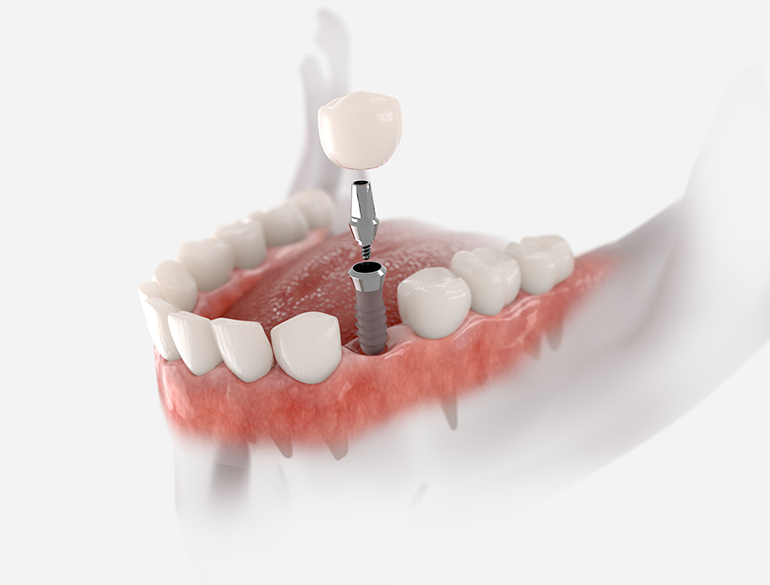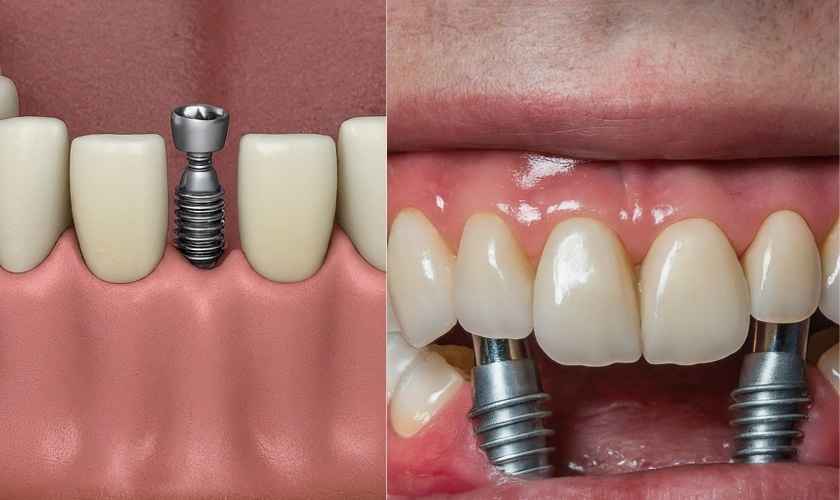Dental Sense Fundamentals Explained
Dental Sense Fundamentals Explained
Blog Article
Unknown Facts About Dental Sense
Table of ContentsMore About Dental SenseHow Dental Sense can Save You Time, Stress, and Money.The Ultimate Guide To Dental SenseThe Facts About Dental Sense Revealed
are clinical gadgets surgically implanted into the jaw to restore a person's ability to chew or their look. They supply assistance for artificial (fake) teeth, such as crowns, bridges, or dentures. When a tooth is lost as a result of injury or condition, a person can experience issues such as rapid bone loss, faulty speech, or adjustments to chewing patterns that cause discomfort.Dental dental implant systems consist of an oral implant body and oral implant abutment and may additionally consist of an abutment addiction screw. Same day dental implants. The oral implant body is operatively put in the jawbone in location of the tooth's root. The dental implant joint is typically attached to the implant body by the joint fixation screw and prolongs via gum tissues right into the mouth to sustain the affixed synthetic teeth
(https://www.intensedebate.com/people/dentalsense1)Framework of The Dental Implant System picking oral implants, talk with your oral provider about the prospective advantages and threats, and whether you are a candidate for the treatment. Things to think about: Your overall health is an important consider determining whether you are a great candidate for dental implants, the length of time it will certainly require to recover, and the length of time the dental implant might stay in place.
Smoking cigarettes may affect the healing procedure and decrease the long-lasting success of the dental implant. The recovery procedure for the dental implant body might take numerous months or longer, during which time you generally have a temporary abutment instead of the tooth. the dental implant treatment: Thoroughly follow the oral health instructions offered to you by your dental service provider.
Little Known Facts About Dental Sense.
Implant failure can result in the requirement for an additional procedure to repair or replace the implant system. Brings back the capacity to eat Recovers aesthetic appearance Helps keep the jawbone from reducing as a result of bone loss Maintains the health of the surrounding bone and gums Aids keep adjacent (close-by) teeth steady Enhances quality of life Damages to bordering natural teeth during implant placement Injury to the surrounding tissues during surgical treatment, such as sinus perforation Injury throughout surgical treatment (as an example, fracture of surrounding jawbone) Poor feature, such as really feeling like the teeth do not attack with each other generally A feeling that the tooth is loose or turning in area arising from an abutment screw loosening Implant body failing (looseness of the dental implant body) due to systemic infection, which might be extra most likely in clients with unrestrained diabetes mellitus as a result of local infection in bone and periodontals their website sustaining the dental implant body because of delayed healing, which may be most likely in people who smoke Difficulty cleansing the gum tissues around the implant, leading to inadequate oral health Neglected periodontal condition Post-surgical pins and needles due to nerve impingement or damages Constantly inform health care suppliers and imaging professionals that you have oral implants prior to any kind of magnetic resonance imaging (MRI) or x-ray procedures.
FDA is not conscious of any kind of damaging occasions reported for MRI or x-ray treatments with dental implants. Oral implants systems are generally made of materials that adhere to international consensus standards of the International Organization for Standardization (ISO) or ASTM International. These criteria have information of what makes a secure product.

A dental implant is a framework that changes a missing tooth. With screw-like tools, the specialist inserts an implant into the jawbone, and it functions as an anchor for a man-made tooth, called a crown. A tool called an abutment connects the artificial tooth to the dental implant. The crown is customized to fit the person's mouth and match the shade of their teeth.
Dental Sense Fundamentals Explained
Some individuals are not eligible for dental implant surgical treatment. It is for oral specialists to operate people with: intense illnessuncontrollable metabolic diseasebone or soft cells illness or infectionIf these problems are fixed, a person can have the surgical procedure. In, oral doctors refrain from running on people with: If people with any one of the above go through oral implant surgical procedure, there is a greater danger of the implant failing.

Dental implant surgical treatment is a tailored process. Offer you time to recover. Connect the post and final crown, bridge or denture.
Next, your surgeon will carefully position the dental implant right into your jaw. Lastly, your specialist will rearrange your gums and close the incision with stitches. If your implant is near the front of your mouth, your dental practitioner will make a momentary tooth for you to put on till you heal. This way, you will not have a space in your smile while you recoup.
Dental Sense Things To Know Before You Get This
Your copyright can inform you what to expect in your situation. During the healing phase, your jawbone should fuse to the oral implant. This process, called osseointegration, is essential for stability and lasting success. This procedure can take anywhere from 3 to nine months. In many cases, it might take much longer.
When your implant heals, your dentist can attach the joint (small adapter post) and your final restoration (crown, bridge or denture). This generally takes about one hour to finish and may call for a 2nd small surgery. You shouldn't feel any kind of pain during your dental implant treatment due to the fact that your provider will certainly use medication to numb your periodontals.
Report this page